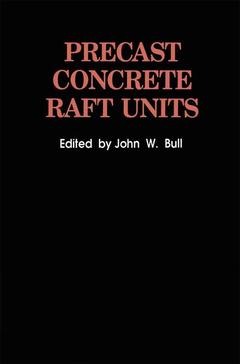Precast Concrete Raft Units, 1991
Langue : Anglais
Auteur : Bull J.W.

The use of precast concrete is a well-established construction technique for beams, floors, panels, piles, walls and other structural elements. The advan tages of precasting include excellent quality control, economical large scale production, improved construction productivity (especially in adverse weather conditions) and immediate structure availability. These advantages have been recognized for precast concrete raft pavement units (raft units) since their introduction in the 1930s. In the last ten years there has been a considerable increase in the use ofraft units, especially in their range of applications, their analysis and their design. However, the description of these developments has been published in academicjournals and conference proceedings which are not readily available to practising raft unit pavement design engineers. Pavement design engineers are underincreasingpressure to produce raft unit designs that are inexpensive, long lasting and able to allow reorganization to accommodate changing use and uncertainty offuture loading requirements. This is the first book devoted to raft unit pavements, and will become a standard work of reference.
1 A review of precast concrete pavements and rafts.- 1.1 Introduction.- 1.2 New precast pavement construction.- 1.2.1 Airfield construction.- 1.2.2 Road construction.- 1.2.3 Precast concrete slabs.- 1.2.4 Slab reinforcement.- 1.2.5 Slab prestressing.- 1.2.6 Fibre reinforcement.- 1.2.7 Precast operations.- 1.3 Pavement repairs with slabs.- 1.4 Concrete pavement design.- 1.4.1 Semi-infinite slabs.- 1.4.2 Finite-sized slabs.- 1.4.3 Concrete fatigue relationships.- 1.4.4 Subgrade loading.- 1.4.5 Slab handling stresses.- 1.5 Joints.- 1.6 Construction.- 1.7 Summary.- 2 Analytical procedures for concrete pavements.- 2.1 Introduction.- 2.2 Concrete pavement subgrade support characterization.- 2.2.1 The dense liquid foundation.- 2.2.2 The elastic solid foundation.- 2.2.3 Can the dense liquid and the elastic solid be compared?.- 2.3 Closed-form solutions for concrete pavement responses.- 2.3.1 Slab resting on a dense liquid foundation.- 2.3.2 Slab resting on an elastic solid foundation.- 2.3.3 Limitations of the closed-form solutions.- 2.4 Computerized numerical analysis methods for concrete slabs-on-grade.- 2.4.1 Computer programs for concrete pavements.- 2.5 Principles of dimensional analysis applied to concrete pavement data interpretation.- 2.5.1 Dimensional analysis and data interpretation.- 2.5.2 Dimensional analysis applied to pavement systems.- 2.5.3 Implications of dimensional analysis: some examples.- 2.6 Conclusions.- 3 The design of precast concrete raft-type pavements.- 3.1 Introduction.- 3.1.1 Raft production and use.- 3.1.2 Raft design and laying.- 3.2 Previous methods of analysis.- 3.2.1 Pre-computer methods of analysis.- 3.3 Repair criteria.- 3.4 Loading.- 3.4.1 Standard axle loadings.- 3.4.2 Non-standard axle loadings.- 3.5 Computer modelling.- 3.6 Raft pavement design method.- 3.7 Design example.- 3.8 Conclusions.- 4 The behaviour of precast concrete raft pavements under fatigue loading with special reference to their use in port areas.- List of symbols.- 4.1 Introduction.- 4.2 Port loading.- 4.2.1 Dynamic loading.- 4.2.2 Static loading.- 4.3 Fatigue behaviour of concrete.- 4.3.1 Plain concrete.- 4.3.2 Reinforced concrete.- 4.3.3 Fatigue models.- 4.3.4 Port pavement model.- 4.4 Structural analysis.- 4.4.1 Analysis models.- 4.4.2 Precast concrete pavement models.- 4.5 Finite element analysis.- 4.5.1 Previous work.- 4.5.2 Current analysis.- 4.6 Conclusions.- 5 Performance improvement of precast, reinforced and prestressed concrete raft units (beam and slab) under impulsive loading.- 5.1 Introduction.- 5.2 Load characteristics.- 5.2.1 Types of impulsive loads.- 5.2.2 Load modelling.- 5.3 Analytical studies.- 5.3.1 Analytical methods.- 5.3.2 Non-linear model.- 5.3.3 Finite element model for beams.- 5.3.4 Finite element model for slabs and handrails.- 5.3.5 Dynamic solution of equilibrium equation.- 5.4 Experimental studies.- 5.4.1 Test program for beams.- 5.4.2 Test program for slabs and handrails.- 5.4.3 Verification of analytical results for beams and slabs.- 5.5 Concepts of performance improvement for impulsive loading.- 5.5.1 Concepts of performance improvement for beams.- 5.5.2 Concepts of performance improvement for slabs and handrails.- 5.6 Conclusions.- 6 The behaviour of plain undowelled raft-type concrete pavement.- 6.1 Introduction.- 6.2 Laying of a plain cement concrete pavement.- 6.3 Effects of temperature change and reversible moisture movement.- 6.4 Structural response.- 6.4.1 Deflection.- 6.4.2 Joint efficiency.- 6.5 Effects of pumping.- 7 Rapid pavement repair using precast concrete rafts.- 7.1 Introduction.- 7.2 Preliminary considerations.- 7.3 Surfacing types.- 7.3.1 Mat systems.- 7.3.2 Flush repair systems.- 7.4 Key factors in repair design.- 7.4.1 Loading.- 7.4.2 Durability.- 7.4.3 Specific military needs.- 7.4.4 Ride quality.- 7.4.5 Installation speed.- 7.5 Repair design.- 7.5.1 Bulk fill.- 7.5.2 Base layer.- 7.6 Raft design.- 7.6.1 Raft size.- 7.6.2 Raft edge detail.- 7.6.3 Raft reinforcement.- 7.7 Repair boundary.- 7.8 Special equipment.- 7.8.1 Subsurface screed beam.- 7.8.2 Raft-lifing beam.- 7.8.3 Concrete cutting saws.- 7.9 Practical experience.- 7.9.1 Early tests.- 7.9.2 Recent developments.- 7.9.3 Heavy aircraft tests.- 7.9.4 Current experience.- 7.10 Road repairs.- 7.11 Future developments.- 8 A review of the analysis, design, manufacture and use of precast concrete raft pavement units.- 8.1 Introduction.- 8.2 Manufacture of raft units.- 8.3 Materials used in raft manufacture.- 8.4 The analysis of raft unit pavements.- 8.4.1 Concrete stress and subgrade stress.- 8.4.2 Analytical and numerical analysis.- 8.4.3 Loading.- 8.5 On-site laying raft units.- 8.5.1 Subbase.- 8.5.2 Joints.- 8.6 Conclusions.- References.
Date de parution : 10-2012
Ouvrage de 193 p.
15.5x23.5 cm
Disponible chez l'éditeur (délai d'approvisionnement : 15 jours).
Prix indicatif 316,49 €
Ajouter au panierThème de Precast Concrete Raft Units :
Mots-clés :
finite element method; materials; stress; structural analysis; uncertainty
© 2024 LAVOISIER S.A.S.
